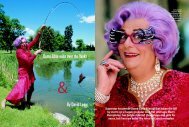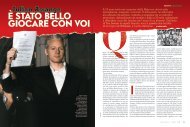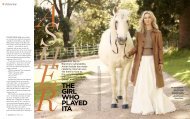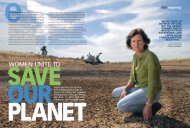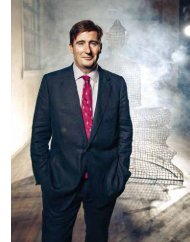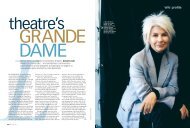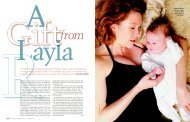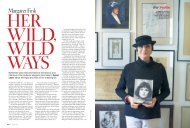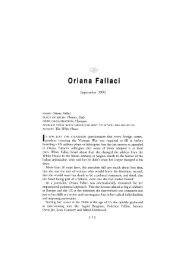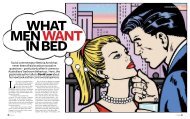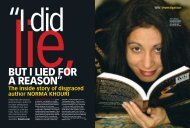The reluctant muse - David Leser
The reluctant muse - David Leser
The reluctant muse - David Leser
You also want an ePaper? Increase the reach of your titles
YUMPU automatically turns print PDFs into web optimized ePapers that Google loves.
Actress and photographer<br />
June Newton, 81,<br />
who works under the<br />
pseudonym Alice Springs,<br />
with mutual portraits<br />
of herself and her late<br />
husband, the controversial<br />
photographer Helmut<br />
Newton, at the opening<br />
of the Museum for<br />
Photography in Berlin,<br />
Germany, last June. His<br />
death in January 2004<br />
left his wife as the guardian<br />
of his artistic legacy.<br />
intimate portrait<br />
<strong>The</strong> <strong>reluctant</strong> <strong>muse</strong><br />
JUNE NEWTON was an actress and a painter, who became famed portrait photographer Alice Springs. She was also the <strong>muse</strong> and wife of<br />
provocative photographer Helmut Newton. Now, some 16 months after his death, June talks to DAVID LESER about love, sex and her life after Helmut.<br />
GETTY IMAGES.<br />
THE AUSTRALIAN WOMEN’S WEEKLY – JUNE 2005 71
“He left magnificently,” says June Newton of her husband,<br />
Helmut, the internationally celebrated – and controversial – photographer who<br />
died in January last year after crashing his car into a retaining wall outside the<br />
landmark Hollywood hotel, Chateau Marmont. “He lived a marvellous life and he went out<br />
magnificently ... he didn’t hit anybody, he didn’t take me with him, he just went out all alone – in usual Newton style.”<br />
We are standing in the driveway of this impossibly<br />
romantic replica French chateau and June is recreating<br />
the scene of her husband’s death.<br />
“His last words were, ‘Follow me, Junie’,” she says,<br />
pointing to the garage and the driveway leading down<br />
onto Sunset Boulevard. Helmut was at the wheel of a<br />
big SUV Cadillac – on loan from General Motors – while<br />
June was in a rented car behind. <strong>The</strong>y were taking<br />
June’s car back to the rental office and then heading<br />
to Mel’s, a favourite diner of Helmut’s, for lunch.<br />
“So he puts his foot on the accelerator,” June adds,<br />
“and then he slumps over the wheel and goes from zero<br />
to 35 miles an hour in three seconds.<br />
“<strong>The</strong>re’s a woman photographer coming around<br />
the corner. He misses her. <strong>The</strong>re’s a guy up here on a<br />
ladder painting the wall. He misses him. Had the car<br />
been in a different position, he would have gone out<br />
onto Sunset Boulevard. Look at all this traffic. Bang.<br />
But instead he hits this wall where the ivy hasn’t<br />
grown since ... It was perfect. He did it in style. He had<br />
somebody choreographing it for him I think ...”<br />
For such an extraordinary life as Helmut Newton’s<br />
one might have expected such a bravura performance.<br />
Yet consider now the performance of his 81-year-old wife.<br />
On the day of his death – January 23, 2004 – as<br />
Helmut was rushed to Cedars-Sinai Medical Center having<br />
suffered a fatal heart attack, June was joined at the<br />
hospital by some of their dearest friends, among them<br />
Philip Pavel, the general manager of Chateau Marmont,<br />
Joan Juliet Buck, the former editor-in-chief of French<br />
Vogue, Jan Sharp, the film-maker and wife of Australian<br />
director Phillip Noyce, and Anjelica Huston, the actress.<br />
<strong>The</strong>y assembled in what turned out to be the children’s<br />
waiting room, sitting on seats designed as Alice in<br />
Wonderland characters. “Look, June,” said one of the<br />
friends, “look where you’re sitting” and June examined<br />
her seat to discover she was sitting on the Mad Hatter.<br />
A shudder went up her spine.<br />
In Paris, they’d been calling June “Alice” for 35 years<br />
– ever since she’d filled in for her sick husband on a photo<br />
shoot for a Gitanes commercial. June had said to Helmut<br />
that day, “Give me the camera, show me what to do and,<br />
if I don’t succeed, you can do it the following week.”<br />
So she’d taken the shots and a new career had<br />
burst forth, except that Helmut hadn’t liked the idea<br />
of her working as June Newton. “He didn’t want me<br />
using his name. It wasn’t a family affair. We weren’t<br />
going to be a couple of photographers: <strong>The</strong> Newtons!”<br />
So, not long afterwards, June and Helmut had gone<br />
to dinner with friends, the actress Jean Seberg and her<br />
Opposite,<br />
clockwise from<br />
bottom right:<br />
Helmut’s picture<br />
of June on the<br />
beach during an<br />
“illicit” weekend<br />
at Inverloch,<br />
Victoria, in the<br />
early days of their<br />
relationship in<br />
the 1940s; June<br />
plays Joan of<br />
Arc in George<br />
Bernard Shaw’s<br />
Saint Joan at the<br />
Princess <strong>The</strong>atre<br />
in Melbourne in<br />
1954; June waters<br />
a plant in the<br />
couple’s Paris<br />
apartment, circa<br />
1970; Self-portrait<br />
with Helmut,<br />
Chateau Marmont,<br />
Hollywood, 1991.<br />
Spanish boyfriend, Ricardo, and Helmut had asked<br />
June what byline she intended adopting. Ricardo,<br />
sensing she was not going to use her own name, asked<br />
June for an atlas, which he opened at a map of<br />
Australia. He then asked for a pin and told June to<br />
shut her eyes. <strong>The</strong> pin landed right in the centre – on<br />
Alice Springs. “<strong>The</strong>re’s your name,” he declared.<br />
And it was as Alice Springs that she earned an<br />
international reputation in her own right, shooting<br />
fashion for the revolutionary French hair stylist Jean<br />
Louis <strong>David</strong> and magazines such as Depeche Mode and<br />
Elle, and, at Helmut’s urging, then turning to portraits.<br />
“You know, Junie,” he told her one day, “your pictures<br />
of people are better than your fashion pictures. Why<br />
don’t you concentrate on portraits for a while?”<br />
“<strong>The</strong>y will end up in drawers,” she retorted.<br />
<strong>The</strong>y didn’t. <strong>The</strong>y ended up in catalogues, books<br />
and solo exhibitions around the world, many of them<br />
beautiful and unadorned black and whites of the rich<br />
and famous – actresses such as Charlotte Rampling,<br />
Raquel Welch, Catherine Deneuve and Nicole Kidman;<br />
Princess Caroline of Monaco and her son, Andrea; the<br />
couturiers Yves St Laurent and Hubert de Givenchy;<br />
writers Lawrence Durrell, Gore Vidal and Graham<br />
Greene; and, of course, her husband. Helmut in shorts<br />
and high heels. Helmut greeting the dawn in their<br />
garden near St Tropez. Helmut in intensive care after<br />
his heart attack in New York in 1971. Helmut with<br />
Pavarotti. Helmut with his naked models.<br />
And now, 34 years later, in this “City of Angels”, the<br />
doctor is squatting before Alice-in-the-waiting-room,<br />
telling her that her life’s partner, the man described as<br />
“the other side of her”, has gone.<br />
June stands up and, accompanied by Philip Pavel,<br />
walks into the room where Helmut is lying dead in a<br />
minerve or neck brace. What kind of bizarre parody is<br />
this? It was Helmut – with June’s encouragement – who<br />
once scandalised society by dressing his semi-naked<br />
models in surgical corsets, casts and neck braces.<br />
(“I’ve gone too far,” he had told June one day after<br />
photographing a model in a tight harness. “I’ll have to<br />
stop, look at what I’ve done.” “You’re mad to stop,”<br />
June had replied. “It’s just the beginning.”)<br />
“And there he was,” June says now, “as if he was<br />
asleep, lying with this enormous minerve and his<br />
beautiful hair looking like a silver fox, and so I said to<br />
Phil, ‘Shit, I haven’t got a camera’ ... and so he drove me<br />
back to the hotel and I got the camera, loaded it and, as<br />
cool as a cucumber, I went back and photographed the<br />
most beautiful portraits I have ever, or will ever, take.<br />
▲<br />
COURTESY JUNE NEWTON. ALICE SPRINGS/MACONOCHIE PHOTOGRAPHY.<br />
72 THE AUSTRALIAN WOMEN’S WEEKLY – JUNE 2005 THE AUSTRALIAN WOMEN’S WEEKLY – JUNE 2005 73
And they are very unique, because not to my knowledge<br />
has anyone ever photographed their spouse or lover on<br />
the death bed.”<br />
Not only that, but somehow she also thought to cut<br />
off some of those silver locks. “I said to the nurse, ‘Find<br />
me a pair of scissors’ and I said, ‘You won’t be needing<br />
this, Helmut’. And I took a big snip of his hair and it’s<br />
in the <strong>muse</strong>um [in Berlin, where the biggest collection<br />
of his photographs is displayed].”<br />
Helmut Newton died at the age of 83, four days<br />
before he was to shoot a deodorant commercial for Soft<br />
& Dry. Models, hairdressers, his agent from Milan, the<br />
production manager, two clients, everybody was at the<br />
ready in Los Angeles. What to do?<br />
“Let’s have lunch,” said June, and with that a few of<br />
them headed to Mel’s for a hamburger, where June<br />
announced she would be filling in for Helmut on the ad<br />
campaign. “Here was this incredible scenario,” Philip Pavel<br />
tells <strong>The</strong> Weekly, “of the widow in this moment, on the day<br />
[of his death], saying she was going to do this job ... And<br />
we went to the set and I saw what a great thing it was,<br />
because she channelled some energy from where I don’t<br />
know, but it was so strong and controlled and in charge.”<br />
“And I’ve never lost it,” June adds. “I haven’t lost it<br />
since that day ... I have become more aggressive and<br />
assertive since Helmut’s death. I have lost the other side<br />
of me, but I never knew the side I had was so strong.”<br />
Which probably helps to explain why, when she and<br />
I arrive at Mel’s for lunch shortly after our first meeting,<br />
June lets it be known she’s in charge – ordering the tuna<br />
melt to share, the Santa Fe salad, the coleslaw on the<br />
side and the glass each of chardonnay. I am completely<br />
at her mercy.<br />
THIS IS ONE OF THOSE FABULOUS head-spinning<br />
tales that gathers you up in its wake, hurtling you from<br />
one side of the world to the other, into the currents of<br />
fashion, art and high society, and out into the slipstream<br />
of two extraordinary people’s lives.<br />
Helmut Newton’s was the one the public came<br />
to know more about – the product of prosperous<br />
German Jewish parents who fled the Nazis before the<br />
outbreak of World War II and ended up in an Australian<br />
internment camp in 1940 for two-and-a-half years,<br />
before being drafted into the Australian army.<br />
Born in Berlin in 1920, he had been a sickly and<br />
fearful child, spoilt rotten by his mother, who often<br />
dressed him up in girls’ clothes and never discouraged<br />
him from the belief that everyone else’s needs were less<br />
important than his own. By his own admission, he was<br />
“insufferable”, but “cute”.<br />
By the time he was 13, he had developed a sleek but<br />
powerful swimmer’s body and a lurid imagination. He<br />
was besotted with photography and obsessed by sex.<br />
By the time he arrived in Australia in 1940 as a 20-yearold,<br />
he’d spent much of the previous two years as a selfdescribed<br />
“gigolo” for an older woman in Singapore.<br />
Helmut was, of course, to become – in the words of<br />
American Vogue – “fashion’s infamous provocateur”.<br />
He pushed all the boundaries, broke all the taboos.<br />
Nothing was beyond his bold imaginings – Amazonian<br />
women wearing chains<br />
“I have become more<br />
aggressive and assertive<br />
since Helmut’s death. I<br />
have lost the other side of<br />
me, but I never knew the<br />
side I had was so strong.“<br />
and dog collars, models in<br />
wheelchairs and neck braces,<br />
women with saddles on<br />
their backs ... He carried<br />
accessories in his car – false<br />
nipples, handcuffs, whips,<br />
leg irons ... Little wonder<br />
that over the years he was<br />
denounced as a deviant,<br />
pervert and peeping Tom.<br />
He didn’t care. “<strong>The</strong> right<br />
girl at the right moment has always been my<br />
inspiration,” he once wrote.<br />
And who better to find for a lifetime of inspiration<br />
than the actress June Browne (later to become known<br />
as June Brunell because of another Melbourne actress<br />
called June Brown).<br />
As a little girl growing up in rural Victoria, June had<br />
been enchanted by the box office and had written to<br />
stars such as Claudette Colbert and Gary Cooper,<br />
letting them know how talented she was and asking<br />
whether she could come to Hollywood.<br />
As a star-struck teenager, she had been told by a<br />
reader of tea leaves that she would be surrounded by<br />
cameras all her life, only she would “never be in front<br />
of them”. Later, as a young actress in Melbourne, her<br />
obsession with movies had grown to the point where<br />
she would often leave a theatre pretending to be Greta<br />
Garbo or Bette Davis.<br />
She was attractive, sexy and funny – and had<br />
numerous admirers, as evidenced by the names of<br />
many of them embroidered on her white sweater.<br />
One day in 1946, June walked into Helmut Newton’s<br />
penthouse studio in Flinders Lane, Melbourne, hoping<br />
to get some extra modelling work, but expecting to find<br />
Above: Helmut,<br />
then 76, and June,<br />
74, at a fashion<br />
show in Paris in<br />
1997. She always<br />
encouraged his<br />
more outrageous an old man behind the lens. Instead, she found a<br />
photography. sophisticated, handsome young European who,<br />
CORBIS/APL.<br />
▲<br />
74 THE AUSTRALIAN WOMEN’S WEEKLY – JUNE 2005 THE AUSTRALIAN WOMEN’S WEEKLY – JUNE 2005 75
judging by the photographs on his walls, was also an<br />
exceptional talent.<br />
<strong>The</strong>y began dating, with Helmut playing the role of<br />
“stage-door Johnny” to June’s rising theatrical star.<br />
Every night after work, he would sit in the back row to<br />
watch her perform. He was fascinated.<br />
“I’d never met an actress [before],” Helmut wrote in<br />
his autobiography, published two years before he died.<br />
“[And] she always made me laugh. She still does today.<br />
She was very amusing. She was a great singer, too. I<br />
remember driving for hours ... and June singing all<br />
these wonderful songs. Australian songs. English<br />
songs. Stuff from Shakespeare. It was a totally different<br />
affair from any I’d had with any other girl. Because all<br />
the other girls were really only about f***ing. With her,<br />
there was another dimension.”<br />
Not long after the couple first made love, Helmut<br />
proposed. It was under a full moon by the lake in Albert<br />
Park. “I can’t offer you anything,” he told her. “You’d<br />
be crazy to say yes – I wouldn’t if I were you – but think<br />
about it.” June said yes immediately.<br />
<strong>The</strong> Newton marriage was to last from May 1948<br />
until that day in January last year when Helmut<br />
suffered an electrical storm in his heart and drove his<br />
Cadillac into the hotel wall. More than a marriage, it<br />
was a collaboration, a conspiracy, a communion of<br />
ideas, photography, fashion, people and places that<br />
spanned more than half a century.<br />
“I don’t like being called a <strong>muse</strong>,” June tells <strong>The</strong><br />
Weekly. “A <strong>muse</strong> means that you haven’t got a career<br />
yourself, that you’re an appendage to somebody else.<br />
But even though I had my own life, I was his <strong>muse</strong>. He<br />
knew he could call on me for anything and I always<br />
came up with something.”<br />
This was particularly so before Helmut’s heart attack<br />
in 1971, after which his journey towards becoming the<br />
“Even though I<br />
had my own life,<br />
I was his <strong>muse</strong>.<br />
He knew he could<br />
call on me for<br />
anything and I<br />
always came up<br />
with something.”<br />
Above: June with<br />
German Chancellor<br />
Gerhard Schroeder<br />
(front) and Berlin<br />
mayor Klaus<br />
Wowereit at a<br />
memorial service<br />
for Helmut in the<br />
photographer’s<br />
native Berlin<br />
last June. A<br />
funeral director<br />
(right) holds the<br />
urn containing<br />
king pin of stylish erotica was largely self-determined.<br />
“In the days when collections were happening twice<br />
or four times a year, prêt à porter came in, haute<br />
couture ... If you weren’t a studio photographer, you<br />
had to have ideas, something to hang them on.<br />
“So we would sit up to all hours in the night, smoking<br />
and drinking Scotch, until I would get something for<br />
Helmut to hang it on.<br />
“He knew that I admired his work ... and could help<br />
him and criticise it, and pull it apart and talk about it.<br />
It’s wonderful to have somebody to talk about your<br />
work with, who understands you so well ...”<br />
No true assessment of Helmut Newton’s extraordinary<br />
life and body of work can, therefore, be made without<br />
factoring in this crucial element. Not only did June<br />
hatch some of his earliest and wildest visions – models<br />
and fighter planes, models and mechanical bears,<br />
models and store dummies, models in manacles, plus<br />
a collection of nudes called White Women – she also<br />
curated his exhibitions, edited his books, played to his<br />
camera, naked or semi-naked ... and on one famous<br />
occasion dressed up for him as Adolf Hitler, while Jerry<br />
Hall posed as Eva Braun.<br />
Helmut Newton’s grand ambition had always been<br />
to work for Vogue and he realised this in the mid-tolate<br />
1950s, when he began working<br />
for the Australian supplement of<br />
English Vogue. Later, he worked for<br />
the English and Australian editions,<br />
but it was only in 1961, when he<br />
joined French Vogue, that his career<br />
really began to soar.<br />
“Helmut never tried to develop porno<br />
chic. It was always there in him. But<br />
he had to be in Europe for this to<br />
grow, for it to blossom,” she says.<br />
Once in Paris, June soon realised<br />
she had to make a decision – to keep<br />
acting and commute to London, where<br />
she had worked in 1958 playing Nurse<br />
Jane in the BBC radio series <strong>The</strong> Flying Doctor, or to<br />
remain with Helmut. “I realised that I was happiest with<br />
Helmut and ... that’s the road I chose.”<br />
Yet there was clearly a void to fill. “I knew that as a<br />
wife, just as a wife, it wasn’t going to work. He wouldn’t<br />
have liked it and I wouldn’t have liked it ... So that’s<br />
when I decided to paint.”<br />
Initially, it was of the sheets hanging out to dry from<br />
the window opposite their apartment, then later paintings<br />
of her song-and-dance-man father, Tom, whom she’d<br />
only known as a small child, and her old draught horse,<br />
Darkie – beautiful, poignant, almost naïve renderings<br />
of characters from her rural Australian life.<br />
<strong>The</strong> actress June Brunell had suddenly become the<br />
painter June Newton, as she would eventually become<br />
the photographer Alice Springs.<br />
IT WAS A JOKE THAT FINALLY HELPED persuade June<br />
Newton to agree to an interview with me in Los Angeles.<br />
In a list of advance questions, I included one about her<br />
adopted name. “What would she have done if that pin<br />
Continued on page 232.<br />
Helmut’s remains. GETTY IMAGES.<br />
76 THE AUSTRALIAN WOMEN’S WEEKLY – JUNE 2005 THE AUSTRALIAN WOMEN’S WEEKLY – JUNE 2005 77
THE RELUCTANT MUSE Continued<br />
had fallen on Wagga Wagga instead of<br />
Alice Springs?” June had dined out on it<br />
for weeks. “When I’m introduced, I want to<br />
be introduced as Wagga Wagga,” she told<br />
friends breezily. “But people who know<br />
me, well, they can just call me Wagga.”<br />
And here she is now – June, Alice, Wagga<br />
– a diminutive but sprightly figure with a bob<br />
of brown hair, standing at the door to her<br />
suite at the Chateau Marmont with a look of<br />
be<strong>muse</strong>ment on her still-youthful face.<br />
This hotel is where Helmut and June<br />
spent their winters every year for the past<br />
quarter of a century, away from their<br />
apartment home in Monte Carlo and the<br />
biting cold of the mistral. It is where they<br />
celebrated their 50th wedding anniversary<br />
seven years ago – a glamorous sit-down<br />
black tie event with friends such as<br />
directors Billy Wilder and Robert Altman,<br />
and British artist <strong>David</strong> Hockney. It is where<br />
Helmut photographed his 1992 series<br />
“Domestic Nudes”; it is where June did<br />
some of her best photographic portraits –<br />
Terence Stamp on the bed, Dennis Hopper<br />
against the back wall ...<br />
amba2605aww Page 1 7/4/05 1:52 PM<br />
“It was very difficult to come back here,”<br />
she admits, “but we were told when we<br />
were kids that, if we fell off the horse<br />
works where it hurts<br />
we had to get right back on it, otherwise<br />
we’d never ride again. So I knew I had to<br />
come back here and face it ... especially<br />
for the first anniversary. I had to be where<br />
it happened.”<br />
And so on January 23 this year, June<br />
invited 60 of her friends to dine in the<br />
penthouse overlooking the canyons of<br />
Hollywood. And there she was, the<br />
perfect hostess, clinking her glass ... “let’s<br />
hear it for Helmut” ... and a video with<br />
Helmut’s voice reducing the room to a<br />
reverent silence.<br />
<strong>The</strong>re had been so many memorable<br />
evenings here. Two years earlier, June had<br />
stood and sung Home Sweet Home, which<br />
Nellie Melba had once made famous, and<br />
as she’d hesitated before the high notes,<br />
friend Mel Brooks, the grand master of<br />
movie satire, had urged her on, “Go for it<br />
June, go for it”. And then a year later, at a<br />
memorial luncheon for Helmut, June had<br />
caused a collective shiver with her moving<br />
rendition of Irving Berlin’s What’ll I Do?<br />
She was always singing for “Helmie”,<br />
in the kitchen, in her sleep, but especially<br />
at his funeral in Berlin in June last year,<br />
where she trilled the words to Schubert’s<br />
Ungeduld (Impatience) in front of a packed<br />
congregation that included the German<br />
Discover<br />
soothing relief with<br />
Tiger Balm.<br />
Tiger Balm is a natural blend of the finest<br />
quality essential oils. Tiger Balm provides<br />
soothing relief from muscular aches and<br />
pains, arthritis and backaches. Try Tiger<br />
Balm White as a chest rub to relieve nasal<br />
congestion naturally without drowsiness.<br />
Tiger Liniment is perfect for massage or a<br />
warm up rub prior to exercising.<br />
If it hurts, try Tiger first.<br />
Chancellor and the mayor of Berlin.<br />
“Thine is my (mein) heart<br />
And shall remain forever more ...”<br />
Yet, as June says now, without a trace<br />
of self-pity, the music has stopped. “I’ll<br />
never have fun again. <strong>The</strong> light went out<br />
when Helmut left ... <strong>The</strong> difficulty is that<br />
I didn’t realise how much time we spent<br />
together in Los Angeles just hanging out<br />
with one another. <strong>The</strong> days were filled with<br />
movies and coffees, and conversation. So<br />
that’s the most difficult thing – not realising<br />
how much one took these mundane little<br />
things of happy married life for granted.”<br />
This of course begs a multitude of<br />
questions about “happy married life”. How<br />
did one maintain such a state of union<br />
with a man the Americans liked to call the<br />
“king of kink”? Did she share his lifelong<br />
fascination with vice or twisted sexuality?<br />
“He didn’t have any,” June scoffs. “It<br />
was all a game with him ... he wasn’t<br />
obsessed with sex. He was obsessed with<br />
work and sex was a lot of his work.<br />
“As he said, ‘If I’d lived the life of my<br />
photographs, I’d have been dead long ago,<br />
from exhaustion.’ He could never be seen<br />
without a camera. A lot of men can’t be<br />
seen without a woman, but cameras<br />
mattered to Helmut more than anything.”<br />
Always read the label. Use only as directed. If symptoms persist<br />
amba2605/aww<br />
232 THE AUSTRALIAN WOMEN’S WEEKLY – JUNE 2005<br />
consult your health care professional. www.keypharm.com.au<br />
CHC 34493-02/05<br />
Did he get turned on by his models?<br />
“You have to get turned on by whatever<br />
you’re doing,” she replies. “You have to<br />
fall in love with them, but you don’t have<br />
to do anything to them ... He always said,<br />
‘Never, ever think about having sex with<br />
the model because that will destroy the<br />
picture. You either go to bed with them or<br />
you photograph them.’ ”<br />
Of course, sometimes Helmut did both,<br />
but it seems never to have threatened their<br />
relationship. “No affair would have split us<br />
up,” she says matter-of-factly. “Our marriage<br />
was never in jeopardy with people.<br />
“But we never had an understanding<br />
– nothing like that. I would never have<br />
lived with a person where you had to have<br />
an understanding. If things happen, well<br />
... This marvellous French philosopher<br />
once said, ‘For the perfect harmony and<br />
happiness, learn how to let the wind blow<br />
freely between the cypress and the oak’.”<br />
I suggest to June that she held more<br />
sex appeal for Helmut than most women;<br />
that, in fact, she was quite a dish in her<br />
time. “I was never beautiful and I’ve never<br />
regretted not being beautiful,” she says.<br />
“Beauty ages very fast. It must be awful<br />
to be a great beauty when you’re young<br />
and to see time melt it away ...<br />
“[As for the] sex ... that is something<br />
that happens if you’re lucky between you<br />
and it’s very rare that it happens all<br />
through 56 years, the same sex. It would<br />
be a very dull and boring life if it was the<br />
same sex through all that time.<br />
“<strong>The</strong> marriage was not based on sex<br />
appeal. I hope you understand that sex<br />
appeal is a very ephemeral thing. What<br />
you see in his work was not Helmut.<br />
<strong>The</strong>re was another man behind the work<br />
and that’s who I was with.”<br />
June won’t reveal exactly who that man<br />
was, but there is enough on the public<br />
record to suggest he was utterly dependent<br />
on his wife. When in 1982 she fell seriously<br />
ill, Helmut became suicidal with despair,<br />
going so far as to play Russian roulette with<br />
the trucks outside their Monaco apartment.<br />
During her recovery, he would go to a<br />
park bench and cry. “I had no powers of<br />
concentration,” he was to admit. “I was<br />
never going to pick up a camera again.<br />
When I was in the apartment, I followed<br />
June around like a dog. She was my<br />
tower of strength.”<br />
And she knew it, only she was wise<br />
enough to allow Helmut the public adulation<br />
he craved. “I knew who the leader of<br />
the pack was and I never usurped his<br />
position. I never spoke out of turn. It was<br />
Helmut’s show.”<br />
JUNE NEWTON HAS NEVER LOST HER<br />
childhood love of acting and during the<br />
three days I was to spend with her in and<br />
around Hollywood, I saw a masterful<br />
performance of her in the role of widow.<br />
Not the grieving widow – although there<br />
were times when she nearly allowed<br />
her desolation to surface. Nor the merry<br />
widow – although once again she was<br />
uproariously funny.<br />
No, in this incarnation she was more<br />
the tough, cranky, unyielding and deeply<br />
driven widow who was now filling the space<br />
her husband had left behind, making it her<br />
life’s purpose to see his legacy flourish.<br />
Five months after Helmut died, his<br />
remains were interred in a small cemetery<br />
in the German capital. He’d been given an<br />
honorary grave by the mayor of Berlin, a<br />
few metres from where film legend Marlene<br />
Dietrich was buried.<br />
Two days later, the Helmut Newton<br />
Foundation had opened across the road<br />
from the train station where Helmut had<br />
said goodbye to his parents in 1938. It is this<br />
<strong>muse</strong>um and permanent exhibition space<br />
for Helmut and June’s work, to which<br />
June is now dedicating her life.<br />
“I can’t let Helmut down,” she says.<br />
“We didn’t come all this way together for<br />
one of us to let the other down. [My life]<br />
is bound up with Helmut ... and I’ll only<br />
see the tip of the iceberg in my life because<br />
his fame is going to grow far beyond the<br />
fame he knew in his lifetime.”<br />
Was she in any way drawn back to<br />
Australia? “No, the only thing I was ever<br />
drawn to was Helmut ... I loved my life in<br />
Australia, but ... home was always where<br />
Helmut was and, now that he’s not here,<br />
I keep the happy home fires burning.”<br />
So where then, I ask her finally, would<br />
she like to be laid to rest? “I thought you<br />
were going to ask me whether I’d like to be<br />
laid,” she says, a gleam in her pale-blue<br />
eyes. “But no ... I haven’t thought about it.”<br />
What she has thought about is whether<br />
Helmut’s spirit might now be somewhere<br />
out there in the ether. “You didn’t see a<br />
black butterfly flying over the pool at<br />
Chateau Marmont?” she asks me. “His<br />
wings are tinged with gold and he has this<br />
little fluttering white butterfly after him<br />
... which is not me, of course, because<br />
I’m still here.”<br />
No I didn’t see it, I tell her. “Well, I<br />
wonder who it is,” she says with a devilish<br />
laugh. “I don’t think it’s his guardian<br />
angel, do you?” W<br />
Mrs Newton: June Newton a.k.a Alice Springs,<br />
an autobiographical collection of diary entries,<br />
portraits and photographs, is published by<br />
Taschen, rrp $85.<br />
pure sof tness<br />
pure sof tn ess<br />
pure sof tness<br />
pure sof tness<br />
pure sof tn ess<br />
pure s of tness<br />
pure sof tness<br />
Swisspers<br />
facial cleansing wipes.<br />
Remove your make-up without<br />
removing your skin’s natural moisture.<br />
www.swisspers.com.au<br />
SHM ACTDV0061
234 THE AUSTRALIAN WOMEN’S WEEKLY – JUNE 2005 THE AUSTRALIAN WOMEN’S WEEKLY – JUNE 2005 235



